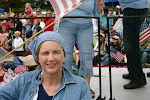Style and Effect in A HARD DAY'S NIGHT
The professor and teaching assistant hated it and gave it a bad grade and wrote condescending negative comments all over it. I guess it wasn't full of enough Marxist-Freudian film-school terminology for them, or something. However, it represented my thoughts on the movie (as well as my development as a rock journalist) at that time.
Since the entire paper runs more than 2700 words, I've posted it in my www.deviantart.com portfolio. Here's the abstract/introduction:
A Hard Day’s Night (1964) owes its effect to a film style characteristic of the 1960’s. In it rock music and British New Wave cinema combine to create a high-energy, relentlessly compelling, and hilarious docu-drama (actually, docu-comedy). The Beatles—and their music—match the high-energy style that grips the viewer’s attention. As often, the British New Wave cinematic style gave the feeling of a documentary, and here the effect is enhanced by what goes on in front of the camera. When the film deviates from a documentary style, it’s to provide a higher level of energetic rock ‘n’ roll excitement. In turn involving viewers in this high level of creative energy is entirely appropriate to a film starring the Beatles, who were part of the changing times and the musical counter-culture of the sixties.
A Hard Day’s Night remains important because it functions as a contemporary viewpoint that tells a story about some of the most influential musicians of this century—early rock stars when the genre was still being created. The movie remains contemporary, not an artificially backwards look. (Artificially backwards looks are provided in the sixties-set period pieces Stardust and I Wanna Hold Your Hand, for example.)
At the time A Hard Day’s Night was made, rock was still considered a type of non-music—no history, no theory, no culture. [Note: If you disagree, I suggest you read the first American reviews of the Beatles’ music. Perhaps one critic wrote something positive but that had nothing to do with the collective social and cultural attitudes of the time.] The Beatles—partly because of this movie—changed that—along with being a part of so many other changes in the sixties. This film was not made with any magic insight into the future—no film is. Instead it records and presents a spirit that nurtured rock into an entire counter-culture movement, into one of the basic ingredients of what made the sixties what they were.
Here's the link:
http://lynjensen.deviantart.com/art/Style-and-Effect-in-A-HARD-DAY-S-NIGHT-482980337


0 Comments:
Post a Comment
Subscribe to Post Comments [Atom]
<< Home